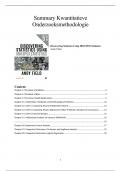Samenvatting
Summary Discovering Statistics Using IBM SPSS - Kwantitatieve Onderzoeksmethodologie (MAN-BPRA247)
- Instelling
- Radboud Universiteit Nijmegen (RU)
This summary contains everything you need to know for the course 'Kwantitatieve Onderzoeksmethodologie' (in Dutch) at Radboud. Note: If you want more chapters of Field's book, I have a bundle containing two summaries, each with different chapters summarised.
[Meer zien]





